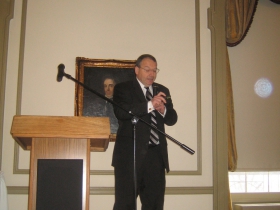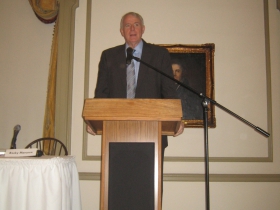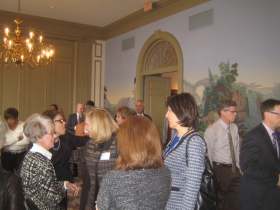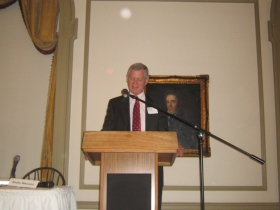Millennials Drive Downtown Growth, GMC Told
Younger residents far more important than empty nesters in driving city growth, and urban areas are surpassing suburbs, speakers at conference note.
Attention Millennials: Capital has spoken.
You win.

Milwaukee Commissioner of the Department of City Development Rocky Marcoux fiddles with the flicker as he gives a whirlwhind slide tour of recent downtown development. Photo by Michael Horne.
“Urban centers are really thriving, especially for the millennials,” he said to a meeting on Downtown development hosted by the Greater Milwaukee Committee Monday, January 13th, at the University Club.
After decades when population followed capital to the suburbs with their cheap land and free parking, capital is now following the creative class — and it’s heading downtown.
Gary Grunau, a pioneering downtown developer [Schlitz Park, Hyatt Regency], who was one of the 100 or so attendees, said, “Suburban office building vacancies are climbing. Downtown office vacancies are declining. The millennials and innovators are down here where they want to be.
“Thirty-five years from now there will be 60 million new people in the US,” he said. “Ninety percent will be in urban areas, not suburbs or rural areas.”
GMC Executive Director Julia Taylor gave introductory remarks to the group and to a panel of real estate experts who came together to apprise members of the GMC on the latest downtown development news. She said our downtown developments like The Couture have caught the attention of others. We “continue to make a mark on the national scene with these changes,” she said.

Milwaukee Mayor Tom Barrett addresses the attendees at the GMC Downtown Development event. Photo by Michael Horne.
Street rebuilding, now underway, was “the first thing to come down the pike,” he said. Barrett and his development team spent weeks formulating a plan to connect downtown to the lakefront, where there is a 25 foot grade differential between E. Wisconsin Avenue and the lakeshore to its east. A tangle of grossly over-designed freeway ramps constructed for a never-built Lake Freeway, lie in the path of the organic growth of downtown.
But the city faced challenges from the state on the matter (and expense) of moving a few ramps a “couple hundred yards to the south,” he said, and timing was of the essence, as the state was itching to get the bridge rebuilt.
The city wanted to move the ramps to create what Marcoux called “the northwest passage to the Third Ward,” as well as to open up several acres of prime real estate to high-density development, including room for a “750,000 to 1 million square foot building … I’m convinced we can get another national headquarters to the site,” Marcoux said of the area generally in the vicinity of N. Jackson St. to N. Harbor Drive and from E. Clybourn St. to E. Chicago St.
But state officials still resisted the push to clear this space, leaving the likelihood this area would be vacant and desolate for at least another 25 years.

Linda Mellowes (l) faces Journal Sentinel publisher and new downtown resident Betsy Brenner (r) while real estate reporter Tom Daykin heads past the decorative wallpaper so reminiscent of the Jean Zuber et Cie hangings in the White House Diplomatic Reception Room. Photo by Michael Horne.
“The governor, the mayor and the county executive worked together on this,” Marcoux said. “Economic development isn’t Red or Blue,” he said. “It’s green.”
Barrett recalled being asked to meet with representatives of Northwestern Mutual who told him they planned to tear down a downtown building of theirs that housed 1,100 people, while planning to find a new home for them and an additional 1,500 workers.
“Is this a good-news meeting, or a bad news meeting?” the mayor asked. At the time, it could have gone either way, and once again the mayor dispatched Rocky Marcoux to help secure the upcoming NML Downtown Campus and to keep any silly ideas about moving to the suburbs at bay.
Sandra Botcher, a panelist who is in charge of the project for the giant insurer said, “when I inherited the campus project in October, I felt like a kid in a $450 million candy store.”
One of the company’s stated goals was to determine “how to better to connect to the community. To bring the community to us rather than to have to go out to the community.”
This had never been much of a concern for the Quiet Company, which has never welcomed the general public into its buildings, and barely tolerated them on its grounds.
“The new campus,” including the NML Gardens “will say, ‘come in. Walk through, sit, have a cup of coffee,'” she said.
There will be a glassy entrance on N. Prospect Ave. where the general public will be welcome without an appointment (or ID card.) She hinted that the company might have displays in the lobby, perhaps a museum of sorts. The “Top of the Tower” on the 32nd floor will also have space for the public, employees and public events, she added. A Mason St. entrance will also be open to the public, as will the company cafeteria. You will be able to cut through the building to get to your bus, she said. The firm is also considering leasing or purchasing the O’Donnell Park parking garage, she said.
Developer Rick Barrett [no relation to the mayor] talked about his plans to build the Couture on the site of the underutilized Downtown Transit Center. “The value of the Transit Center is zero,” he said, basing it on the taxes it generates, but implying it is a drain on the potential growth of the downtown economy. Barrett cited his experience with the former parking lot he owned that is now the site of the highly acclaimed Moderne, a successful and speculative structure built during the Great Recession.
The downtown lakefront “is underutilized, under-taxed and frankly, underwhelming,” Barrett said. “We need cranes in the air. Denver, Minneapolis and Madison have double-digit cranes” active now he said.
Mark Irgens talked about his plans to break ground this spring for an 18-story building at 833 E. Michigan St., just east of the U.S. Bank Galleria. The property sale is scheduled to close at the end of the month, he said. The new structure will be about twice the height of his 875 E. Wisconsin Avenue building, just east of the U.S. Bank Center tower. “There is no 13th floor, so actually it will be 17 not 18 floors,” Irgen said. It is to include 444 on-site parking spaces, a number that would have been higher had he not made arrangements to share parking in the U.S. Bank parking structure, to which his building will be connected. The office tower has 156,000 square feet under lease, and four prospects are currently looking to lease 50,000 square feet in the building. He cited the building’s walkability, cable redundancy, electric service redundancy and flexibility to accommodate new technologies as being important to potential tenants. He also promises a “white tablecloth” restaurant for the building, such as U.S. Bank had for years decades ago.
Joe Ulrich of U.S. Bank told of the behind-the-scenes remodelings that are transforming the state’s tallest office tower, which it owns. Robert W. Baird is currently remodeling 14 floors of space in the 41-story building, he said.
The bank itself hopes to add 300 to 500 people to its downtown workforce, he said. The bank is considering having a hotel development take place north of its new parking structure, where a courtyard now acts as a passive filter for rainwater.
The bank has also partnered with the Bartolotta restaurant group to re-do the cafeteria in the building. Working with Bartolotta, he said, “was like being on a fantasy cooking show.” The bank is investing several million dollars on the common areas of the building to open the space up to larger functions. About 30,000 square feet of lobby space is currently underutilized, he said. The bank is adding a locker room, 24-hour showers and a bike share station to its facility, Ulrich said. These amenities “are being driven by the occupants,” he said, conjuring up images of millennial bankers biking to work and showering down before beginning the day’s work. “They want healthier options and we are responding to that.”

Real Estate attorney Bruce Block addresses attendees. Later he would ask questions of the panelists at the GMC Downtown Development meeting held at the University Club, Monday, January 13th, 2013. Photo by Michael Horne.
Marcoux said the city’s projects have already begun, as anybody who has been in the vicinity of the Milwaukee Public Market and the new N. Milwaukee St. boulevard can attest. Since the former ramps will be used for traffic re-direction during construction, Marcoux figures the area will be open for development in late 2015 or early 2016. The city plans an international marketing effort for the site, and its vicinity, including the desirable lands of the Italian Community Center nearby. Barrett figures his development will get going in the first quarter of 2015 with the building being ready to fill in 2017.
Botcher of NML said demolition (actually de-construction) of its building has already begun. The new tower should be completed and ready for move-in in late 2017. Irgens said his 833 building would get rolling in 2014. Ulrich said the improvements to the U.S. Bank Galleria would be complete in the 4th quarter of 2014.
Finally, Marcoux addressed parking in the millennial age.
“We can’t build a parking lot for every development,” he said. If the city is to build parking garages they need to be “bigger, strategically located and tied into transit,” he said.
These things all take time, Marcoux said. “Twenty-five years ago who would have built in the Third Ward?” he asked. “Now it is built out,” due to what he called the “organic growth” that he expects the millennials to bring here. “The spill-over [from the Third Ward] has already occurred in the 5th Ward.” He expects there will be a 25-year build-out of that area.
“People expected when the Park East [Freeway stub] went down that you sprinkle a little water on it and it will grow,” Marcoux said to the audience of business leaders. “You know that’s not the case.”
Photo Gallery
Political Contributions Tracker
Displaying political contributions between people mentioned in this story. Learn more.
- December 23, 2020 - Tom Barrett received $500 from Rocky Marcoux
- December 27, 2018 - Tom Barrett received $1,000 from Rick Barrett
- December 22, 2018 - Tom Barrett received $500 from Rocky Marcoux
- December 4, 2018 - Tom Barrett received $3,500 from Mark Irgens
- June 23, 2018 - Tom Barrett received $1,000 from Bruce Block
- December 29, 2017 - Tom Barrett received $500 from Rocky Marcoux
- December 13, 2017 - Tom Barrett received $1,500 from Rick Barrett
- November 13, 2017 - Tom Barrett received $1,500 from Mark Irgens
- March 1, 2017 - Tom Barrett received $400 from Rocky Marcoux
- January 18, 2017 - Tom Barrett received $1,000 from Mark Irgens
- March 28, 2016 - Tom Barrett received $200 from Bruce Block
- March 21, 2016 - Tom Barrett received $1,000 from Mark Irgens
- December 21, 2015 - Tom Barrett received $1,000 from Bruce Block
- November 24, 2015 - Tom Barrett received $1,000 from Mark Irgens
- November 6, 2015 - Tom Barrett received $500 from Sandra Botcher
- November 2, 2015 - Tom Barrett received $2,600 from Rick Barrett
Plenty of Horne
-
Notables Attend City Birthday Party
 Jan 27th, 2024 by Michael Horne
Jan 27th, 2024 by Michael Horne
-
Will There Be a City Attorney Race?
 Nov 21st, 2023 by Michael Horne
Nov 21st, 2023 by Michael Horne
-
Sprecher Brewery Aims To Be National Soft Drink Leader
 Oct 20th, 2023 by Michael Horne
Oct 20th, 2023 by Michael Horne


![Developer Gary Grunau (c) bends over to converse with a seated friend at the Greater Milwaukee Committee's meeting on Downtown Development held at the University Club, Monday, January 13th, 2014. [Photograph taken Monday, January 13th, 2014 by Michael Horne.] Developer Gary Grunau (c) bends over to converse with a seated friend at the Greater Milwaukee Committee's meeting on Downtown Development held at the University Club, Monday, January 13th, 2014. [Photograph taken Monday, January 13th, 2014 by Michael Horne.]](https://urbanmilwaukee.com/wp-content/gallery/juneau-town/thumbs/thumbs_img_1612.jpg)
![Mount Mary University President Dr. Eileen Schwalbach (r) talks with an attendee at the Greater Milwaukee Committee meeting about Downtown Development at the University Club. [Photograph taken Monday, January 13th, 2014 by Michael Horne.] Mount Mary University President Dr. Eileen Schwalbach (r) talks with an attendee at the Greater Milwaukee Committee meeting about Downtown Development at the University Club. [Photograph taken Monday, January 13th, 2014 by Michael Horne.]](https://urbanmilwaukee.com/wp-content/gallery/juneau-town/thumbs/thumbs_img_1614.jpg)
![The head table is set for its distinguished guests. [Photograph taken Monday, January 13th, 2014 by Michael Horne.] The head table is set for its distinguished guests. [Photograph taken Monday, January 13th, 2014 by Michael Horne.]](https://urbanmilwaukee.com/wp-content/gallery/juneau-town/thumbs/thumbs_img_1616.jpg)
![Greater Milwaukee Committee chair John Daniels, Jr. steps from the podium after welcoming the attendees to the University Club. [Photograph taken Monday, January 13th, 2014 by Michael Horne.] Greater Milwaukee Committee chair John Daniels, Jr. steps from the podium after welcoming the attendees to the University Club. [Photograph taken Monday, January 13th, 2014 by Michael Horne.]](https://urbanmilwaukee.com/wp-content/gallery/juneau-town/thumbs/thumbs_img_1617.jpg)















“There is no 13th floor, so actually it will be 17 not 18 floors,”
Are people really that silly?
Marvelous set of news, and thank god some reasonable agreement was made about the freeway ramps. Of course I would have town 794 down, but this is certainly better than what’s there now.
As for millenials… all true! but warning! Millenial growth in Milwaukee is rather stalled compared to other cities. Have you guys checked out this report by the Urban Land Institute? http://www.uli.org/wp-content/uploads/ULI-Documents/Emerging-Trends-in-Real-Estate-Americas-2014.pdf
Could be worse, but MKE would be wise to be conservative with some growth expectations and the rest of you cats should be wise to keep promoting economic opportunity. I can’t beleive anyone would ever move to Las Vegas or Orlando but nonetheless, those places are pulling people in because they’re dirt cheap and offer jobs. Milwaukee needs to be mindful!!!
I have to second Tyrell’s message about Millennial growth patterns. The report linked above is a great source to support caution. As a case study, I lived downtown between 2005-2011, but relocated to Orlando, FL precisely due to a lack of job options within in 5 mile radius of where I lived. Milwaukee is leaps and bounds ahead of Orlando in terms of quality of life, urban living, and support for young professionals; but its professional environment is too far behind when it comes to recruitment of younger professionals and retirements. Luckily for me, I am able to boomerang two years after moving and am headed back to live and work downtown, but many people close to me, who went to school in Milwaukee, are still in places like Chicago, New York, Orlando, San Francisco, and Indianapolis; not because they wanted to leave MKE, but rather the opportunities elsewhere.
The report is interesting, I’m just trying to see where they’re getting their estimates. I see a reference to the Moody’s Analytics & the U.S. Census Bureau… although no specific material.
Anyone know where they’re pulling it from? I’m just having a hard time believing that over the next 5 years, Milwaukee has a projected decline of 3.8% for millenials…
Jobs are a huge factor in whether Milwaukee is attracting or losing people, especially millenials. This is a SE WI issue but it seems good-enough has been the status quo for at least a generation.